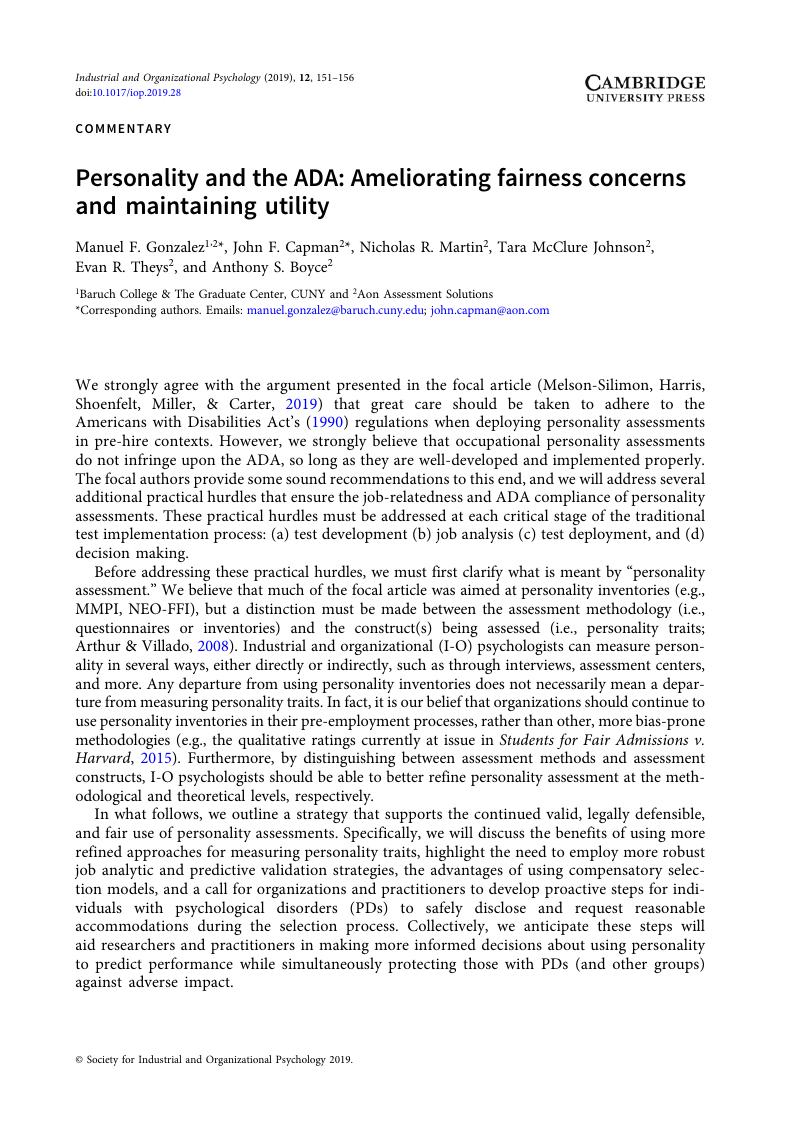No CrossRef data available.
Article contents
Personality and the ADA: Ameliorating fairness concerns and maintaining utility
Published online by Cambridge University Press: 01 August 2019
Abstract
An abstract is not available for this content so a preview has been provided. Please use the Get access link above for information on how to access this content.

- Type
- Commentaries
- Information
- Copyright
- © Society for Industrial and Organizational Psychology 2019
References
Americans with Disabilities Act of 1990. Pub. L. No. 101-336, US Code § 12102, 104 Stat. 328 (1990).Google Scholar
Arthur, W. J., & Villado, A. J. (2008). The importance of distinguishing between constructs and methods comparing predictors in personnel selection research and practice. Journal of Applied Psychology, 93, 435–442.CrossRefGoogle ScholarPubMed
Barrick, M. R., Mount, M. K., & Judge, T. A. (2001). Personality and performance at the beginning of the new millennium: What do we know and where do we go next? International Journal of Selection & Assessment, 9, 9–30.CrossRefGoogle Scholar
Brannick, M. T., Cadle, A., & Levine, E. L. (2012). Job analysis for knowledge, skills, abilities, and other characteristics, predictor measures, and performance outcomes. In Schmitt, N. (Ed.), The Oxford handbook of personnel assessment and selection (pp. 119–146). New York, NY: Oxford University Press.Google Scholar
Hough, L. M., Oswald, F. L., & Ock, J. (2015). Beyond the big five: New directions for personality research and practice in organizations. Annual Review of Organizational Psychology and Organizational Behavior, 2, 183–209.CrossRefGoogle Scholar
Jenkins, M., & Griffith, R. (2004). Using personality constructs to predict performance: Narrow or broad bandwidth. Journal of Business Psychology, 19, 255–269.CrossRefGoogle Scholar
Melson-Silimon, A., Harris, A. M., Shoenfelt, E. L., Miller, J. D., & Carter, N. (2019). Personality testing and the Americans With Disabilities Act: Cause for concern as normal and abnormal personality models are integrated. Industrial and Organizational Psychology: Perspectives on Science and Practice, 12(2), 119–132.CrossRefGoogle Scholar
Ones, D. S., & Viswesvaran, C. (1996). Bandwidth-fidelity dilemma in personality measurement for personnel selection. Journal of Organizational Behavior, 17, 609–626.Google Scholar
Ployhart, R., & Holtz, B. C. (2008). The diversity-validity dilemma: Strategies for reducing racioethnic and sex subgroup differences and adverse impact in selection. Personnel Psychology, 61, 153–172.CrossRefGoogle Scholar
Ren, L. R., Paetzold, R. L., & Colella, R. (2008). A meta-analysis of experimental studies on the effects of disability on human resource judgments. Human Resource Management Review, 18, 191–203.CrossRefGoogle Scholar
Sackett, P. R., Putka, D. J., & McCloy, R. A. (2012). The concept of validity and the process of validation. In Schmitt, N. (Ed.), The Oxford handbook of personnel assessment and selection (pp. 91–118). New York, NY: Oxford University Press.Google Scholar
Samuel, D. B., & Widiger, T. A. (2008). A meta-analytic review of the relationships between the five-factor model and DSM-IV-TR personality disorders: A facet level analysis. Clinical Psychology Review, 28, 1326–1342.CrossRefGoogle ScholarPubMed
Schneider, R. J., Hough, L. M., & Dunnette, M. D. (1996). Broadsided by broad traits: How to sink science in five dimensions or less. Journal of Organizational Behavior, 17, 639–655.3.0.CO;2-9>CrossRefGoogle Scholar
Students for Fair Admissions v. President and Fellows of Harvard College, No. 15-1823 (1st Cir. December 9, 2015).Google Scholar
Tett, R. P., Steele, J. R., & Beauregard, R. S. (2003). Broad and narrow measures on both sides of the personality-job performance relationship. Journal of Organizational Behavior, 24, 335–356.Google Scholar




